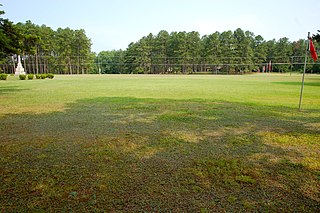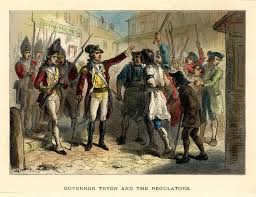
1771 (MDCCLXXI) was a common year starting on Tuesday of the Gregorian calendar and a common year starting on Saturday of the Julian calendar, the 1771st year of the Common Era (CE) and Anno Domini (AD) designations, the 771st year of the 2nd millennium, the 71st year of the 18th century, and the 2nd year of the 1770s decade. As of the start of 1771, the Gregorian calendar was 11 days ahead of the Julian calendar, which remained in localized use until 1923.

Orange County is a county located in the Piedmont region of the U.S. state of North Carolina. As of the 2020 census, the population was 148,696. Its county seat is Hillsborough. Orange County is included in the Durham-Chapel Hill, NC Metropolitan Statistical Area, which is also included in the Raleigh-Durham-Cary, NC Combined Statistical Area, which had an estimated population of 2,368,947 in 2023. It is home to the University of North Carolina at Chapel Hill, the flagship institution of the University of North Carolina System and the oldest state-supported university in the United States.
Francis Nash was a brigadier general in the Continental Army during the American Revolutionary War. Prior to the war, he was a lawyer, public official, and politician in Hillsborough, North Carolina, and was heavily involved in opposing the Regulator movement, an uprising of settlers in the North Carolina piedmont between 1765 and 1771. Nash was also involved in North Carolina politics, representing Hillsborough on several occasions in the colonial North Carolina General Assembly.

Lieutenant-General William Tryon was a British Army officer and colonial administrator who served as governor of North Carolina from 1764 to 1771 and the governor of New York from 1771 to 1777. He also served during the Seven Years' War, the Regulator Movement, and the American War of Independence.

The Yadkin River is one of the longest rivers in the US state of North Carolina, flowing 215 miles (346 km). It rises in the northwestern portion of the state near the Blue Ridge Parkway's Thunder Hill Overlook. Several parts of the river are impounded by dams for water, power, and flood control. The river becomes the Pee Dee River at the confluence of the Uwharrie River south of the community of Badin and east of the town of Albemarle. The river then flows into South Carolina near Cheraw, which is at the Fall Line. The entirety of the Yadkin River and the Great Pee Dee River is part of the Yadkin-Pee Dee River Basin.

The Battle of Moore's Creek Bridge was a minor conflict of the American Revolutionary War fought near Wilmington, North Carolina, on February 27, 1776. The victory of the North Carolina Provincial Congress' militia force over British governor Josiah Martin's and Tristan Worsley's reinforcements at Moore's was a turning point in the war; American independence was declared less than five months later.
James Few was born in 1746 in Hartford. His parents were William Few, Sr., and Mary Wheeler. James migrated with his parents and siblings to Orange County, North Carolina circa 1758.
Herman Husband was an American farmer, pamphleteer, author, and preacher best known as a leader of the Regulator Movement, a populist rebellion in the Province of North Carolina in the years leading up to the American Revolutionary War. Husband was twice elected to the North Carolina assembly but was expelled during his second term.

Great Alamance Creek, also called Big Alamance Creek, is a 37-mile long creek that is a tributary of the Haw River. The creek's headwaters are in Guilford County, but it flows primarily through Alamance County, North Carolina. It is a major source of water for the cities of Burlington and Greensboro through the Lake Mackintosh Reservoir. It was called "Alamance" after an old local Native American word used to describe the blue-colored mud in the bottom of the creek.

Griffith Rutherford was an American military officer in the Revolutionary War and the Cherokee-American Wars, a political leader in North Carolina, and an important figure in the early history of the Southwest Territory and the state of Tennessee.

Alamance Battleground is a North Carolina State Historic Site commemorating the Battle of Alamance. The historic site is located south of Burlington, Alamance County, North Carolina in the United States.
James Moore was an American military officer who served in the Continental Army during the American Revolutionary War. Moore was born into a prominent political family in the colonial Province of North Carolina, he was one of only five generals from North Carolina to serve in the Continental Army. He spent much of his childhood and youth on his family's estates in the lower Cape Fear River area, but soon became active in the colonial military structure in North Carolina.
Claude Joseph Sauthier (1736–1802) was an illustrator, draftsman, surveyor, and mapmaker. He was employed by the British colonial government in the American colonies prior to and during the American Revolutionary War.

General Hugh Waddell was an Irish-born military officer, merchant, planter and politician who served in the Thirteen Colonies during the mid-18th century. Waddell formed and led a provincial militia unit in Rowan County, North Carolina and the Ohio River Valley during the French and Indian War and the Anglo-Cherokee War, and supervised the construction of Fort Dobbs near the settlement of the Fourth Creek Congregation. His career was well-served by close connections to several provincial governors of North Carolina.

The Battle of Alamance, which took place on May 16, 1771, was the final confrontation of the Regulator Movement, a rebellion in colonial North Carolina over various issues with the Colonial Government. The Regulators primarily wanted reforms to the currency act and to stop local corruption. They will also request other changes, like secret ballot voting, progressive taxation, land reform, and more transparent government. Named for nearby Great Alamance Creek, the battle took place in what was then Orange County and has since become Alamance County in the central Piedmont area, about 6 miles (9.7 km) south of present-day Burlington, North Carolina.

Fort Dobbs was an 18th-century fort in the Yadkin–Pee Dee River Basin region of the Province of North Carolina, near what is now Statesville in Iredell County. Used for frontier defense during and after the French and Indian War, the fort was built to protect the American settlers of the western frontier of North Carolina, and served as a vital outpost for soldiers. Fort Dobbs' primary structure was a blockhouse with log walls, surrounded by a shallow ditch, and by 1759, a palisade. It was intended to provide protection from French-allied Native Americans such as the Shawnee raids into western North Carolina.
The Salisbury District Brigade was an administrative division of the North Carolina militia during the American Revolutionary War (1776–1783). This unit was established by the Fourth North Carolina Provincial Congress on May 4, 1776, and disbanded at the end of the war.
The Rowan County Regiment was originally established in about August 1, 1775 as a local militia in Rowan County in the Province of North Carolina. When the North Carolina Provincial Congress authorized thirty-five existing county militias to be organized on September 9, 1775, the Rowan County Regiment was included and all officers were appointed with commissions from the Provincial Congress. The members of the Rowan County Regiment were mostly from what was Rowan County at the time. Prior to establishment of the Rowan County Regiment, many of its officers were active in the Rowan County Committee of Safety. The regiment included 160 known companies and one or more of these companies were engaged in 36 known battles or skirmishes during the American Revolution. After the establishment of the Rowan County Regiment, several other counties were created from Rowan County, including Burke County in 1777, Iredell County in 1788, Davidson County in 1822 and Davie County in 1836.
Captain Benjamin Merrill was an American military officer, gunsmith and planter who served in the militia of Rowan County, North Carolina. He sided with the Regulator Movement in North Carolina, and was captured following the Battle of Alamance on May 16, 1771. Shortly thereafter, he was executed as a rebel by Governor William Tryon.

The Regulator Movement in North Carolina, also known as the Regulator Insurrection, War of Regulation, and War of the Regulation, was an uprising in Provincial North Carolina from 1766 to 1771 in which citizens took up arms against colonial officials whom they viewed as corrupt. Historians such as John Spencer Bassett argue that the Regulators did not wish to change the form or principle of their government, but simply wanted to make the colony's political process more equal. They wanted better economic conditions for everyone, instead of a system that heavily benefited the colonial officials and their network of plantation owners mainly near the coast. Bassett interprets the events of the late 1760s in Orange and surrounding counties as "...a peasants' rising, a popular upheaval."












